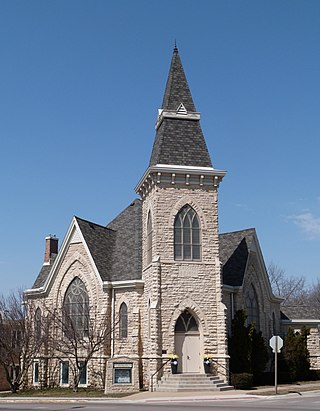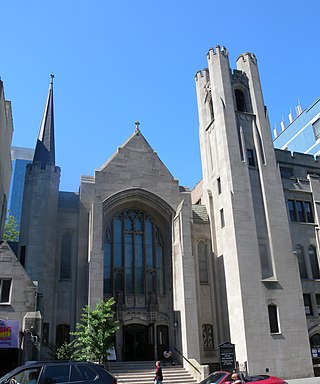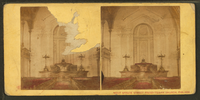
The Presbyterian Church in America (PCA) is the second-largest Presbyterian church body, behind the Presbyterian Church (USA), and the largest conservative Calvinist denomination in the United States. The PCA is Reformed in theology and presbyterian in government.

The Presbyterian Church in the United States was a Protestant denomination in the Southern and border states of the United States that existed from 1861 to 1983. That year, it merged with the United Presbyterian Church in the United States of America (UPCUSA) to form the Presbyterian Church (USA).

The United Presbyterian Church in the United States of America (UPCUSA) was the largest branch of Presbyterianism in the United States from May 28, 1958, to 1983. It was formed by the union of the Presbyterian Church in the United States of America (PCUSA), often referred to as the "Northern" Presbyterian Church, with the United Presbyterian Church of North America (UPCNA), a smaller church of Covenanter-Seceder tradition at a conference in downtown Pittsburgh, Pennsylvania, in May 1958. Vigorous ecumenical activity on the part of PCUSA leaders led to this merger, something of a reunion of two long-separated branches of the larger Presbyterian family deriving from the British Isles.

James Montgomery Boice was an American Reformed Christian theologian, Bible teacher, author, and speaker known for his writing on the authority of Scripture and the defence of Biblical inerrancy. He was also the Senior Minister of Tenth Presbyterian Church in Philadelphia from 1968 until his death.
The Alliance of Confessing Evangelicals is an organization of Christian individuals that believes evangelicals have largely forgotten the foundations of the Christian Gospel and is dedicated to calling on the Protestant churches, especially those that call themselves Reformed, to return to the principles of the Protestant Reformation. To that end, they produce print and internet resources, broadcast radio programs and organize conferences aimed at teaching the Reformed version of the Christian message.

Jennings Ligon Duncan III is an American Presbyterian scholar and pastor. He is Chancellor of Reformed Theological Seminary.
The Reformed Presbyterian Church, Evangelical Synod was a Reformed and Presbyterian denomination in the United States and Canada between 1965 and 1982.
Mariano Di Gangi was a minister of the Presbyterian Church in Canada.

The First Presbyterian Church in Chattanooga, Tennessee, located at 554 McCallie Avenue, is a historic, downtown congregation of the Presbyterian Church in America (PCA). It was the first Christian congregation founded in the city.
Briarwood Presbyterian Church is a congregation of the Presbyterian Church in America located in suburban Birmingham, Alabama.

The National Presbyterian Church is a Christian congregation of approximately 1,500 members of all ages from the greater metropolitan Washington, D.C. area. The mission statement of the church is "Leading People to Become Faithful Followers of Jesus Christ Together in God's World"

Fifth Avenue Presbyterian Church is a Presbyterian Church (U.S.A.) church in New York City. The church, on Fifth Avenue at 7 West 55th Street in Midtown Manhattan, has approximately 2,200 members and is one of the larger PCUSA congregations. The church, founded in 1808 as the Cedar Street Presbyterian Church, has been at this site since 1875.

First Presbyterian Church is located in Marion, Iowa, United States. It was listed on the National Register of Historic Places in 1992.

Saint Luke's Lutheran Church, once known as The German Evangelical Lutheran Saint Luke's Church, is a historic Lutheran church located on Restaurant Row at 308 West 46th Street between Eighth and Ninth Avenues in the Theater District of Manhattan, New York City.

The Brick Presbyterian Church is a large congregation at Park Avenue and 91st Street on the Upper East Side of Manhattan in New York City. A congregation of the Presbyterian Church (U.S.A.), it is known for its Day School and music programs. It was founded as an offshoot of First Presbyterian Church. Its first building, in Lower Manhattan, opened in 1768. The Park Avenue location opened April 14, 1940.

Presbyterianism has had a presence in the United States since colonial times and has exerted an important influence over broader American religion and culture.

First Presbyterian Church in Schenectady, New York is a historic Presbyterian Church in America congregation.

Fairfield Presbyterian Church is a historic Presbyterian Church in America congregation in the Fairton section of Fairfield Township in Cumberland County, New Jersey. It was founded in 1680 when a log church was built on the banks of the Cohansey Creek, and it is the oldest existing congregation currently within the PCA. This log church was replaced by a New England style frame building sometime between 1713 and 1715.

First Presbyterian Church is a historic Presbyterian congregation in Hattiesburg, Mississippi, founded in 1882 by Rev. A. B. Coit. It was the first church in the town and predated Hattiesburg's own incorporation by two years. In 1973 it left the Presbyterian Church in the United States to become a charter member of the more theologically conservative Presbyterian Church in America.
The Independent Presbyterian Church is a Presbyterian Church in America church in Memphis, Tennessee, with somewhere over a thousand members.






























